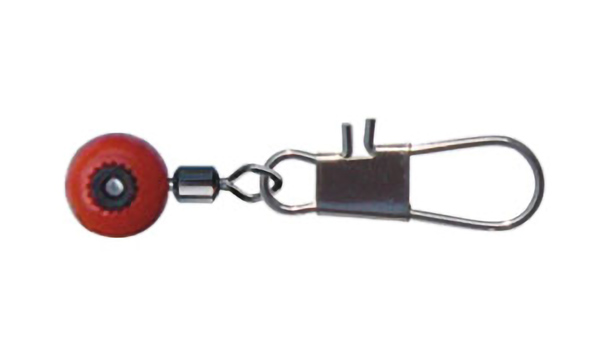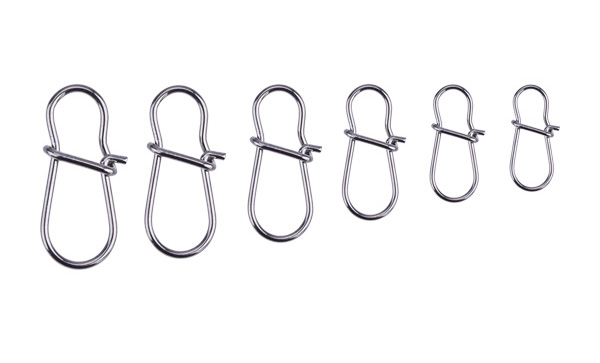

Fishing swivels are an essential yet often overlooked p […]
Fishing swivels are an essential yet often overlooked piece of fishing tackle. They are small, simple devices that play a crucial role in improving the effectiveness of your fishing setup. Whether you're a novice angler or an experienced pro, understanding the different types of fishing swivels, their applications, and how to choose the right one can enhance your fishing experience.
What Are Fishing Swivels?
Fishing swivels are small, rotating devices that are attached to the fishing line. They are designed to prevent line twist, provide a smooth connection between different fishing components, and make it easier to attach lures, hooks, or leaders to your main fishing line. Essentially, they allow for freedom of movement in the water without compromising the integrity of your line.

Why Use Fishing Swivels?
Preventing Line Twist: One of the primary functions of a swivel is to prevent line twist. As a lure or bait moves through the water, it can cause the line to spin, leading to tangles, weakened lines, and difficulty casting. Swivels help eliminate this problem by providing a smooth rotation point, allowing the line to move freely.
Improving Lure Action: Swivels can also improve the action of your lure or bait. When fishing for species that require specific movements, such as trolling or jigging, swivels enable the bait to move more naturally and effectively in the water.
Connecting Lines and Leaders: Swivels are essential when connecting the main line to a leader or when using multiple types of line. They provide a secure and easy connection that won’t fail under pressure, even with larger or stronger fish.
Types of Fishing Swivels
Each type of swivel is designed for specific uses and fishing styles. Here's a breakdown of the most common types of fishing swivels and their advantages and disadvantages.
1. Barrel Swivels
Common Uses: Barrel swivels are the most commonly used type, especially for connecting hooks or lures to the main line in both freshwater and saltwater fishing.
Pros:
Durable and reliable for everyday use.
Simple design that is easy to use and inexpensive.
Cons:
Can be bulky, which may not be ideal for small fish or ultra-light tackle setups.
2. Snap Swivels
Common Uses: Snap swivels are great for quickly changing lures or hooks without needing to cut the line. They are often used in trolling and bait fishing.
Pros:
Quick and easy to use.
Allow for fast lure changes.
Helpful for anglers who frequently switch fishing rigs.
Cons:
May not be as strong as other swivel types.
The snap can wear out over time, causing potential failure.
3. Three-Way Swivels
Common Uses: These are used when you need to attach multiple lines or rigs, such as when you're fishing with two lures or a baited hook and weight.
Pros:
Versatile and effective for multi-line setups.
Perfect for situations where multiple connections are needed.
Cons:
Can become tangled more easily with multiple rigs.
Requires more careful handling and rigging.
4. Ball Bearing Swivels
Common Uses: Ball bearing swivels are designed for high-speed fishing applications, such as trolling, where minimizing line twist is critical.
Pros:
Extremely smooth operation, even under heavy stress.
Ideal for high-speed trolling and large fish.
Cons:
More expensive than other types of swivels.
Not necessary for lighter tackle setups.
5. Crane Swivels
Common Uses: These swivels are typically used in freshwater fishing with lighter tackle and are popular in baitcasting setups.
Pros:
Reliable and compact.
Works well for light tackle fishing.
Cons:
Less effective for heavy-duty applications.
May not handle larger fish as well as stronger swivel types.
6. Rolling Swivels
Common Uses: Rolling swivels are designed to reduce line twists and are commonly used when fishing for large species in both saltwater and freshwater.
Pros:
Smooth rotation and minimal line twist.
Great for fishing with larger baits or heavier tackle.
Cons:
More expensive than basic barrel swivels.
Can be too large for smaller tackle setups.

How to Choose the Right Fishing Swivel
Choosing the right fishing swivel depends on several factors:
1. Size and Strength
Matching Swivel Size to Line Weight: Ensure that the swivel can handle the weight of your fishing line and the size of the fish you’re targeting. Larger fish require more robust swivels.
Considering Target Fish Size: For big game fishing, opt for heavy-duty swivels, whereas smaller swivels are sufficient for panfish and trout.
2. Material and Construction
Brass vs. Stainless Steel: Brass swivels are often used in freshwater due to their corrosion resistance, while stainless steel swivels are preferred for saltwater fishing for added durability and strength.
Quality of Construction: The higher the quality, the longer the swivel will last, especially under harsh fishing conditions.
3. Fishing Technique
Choose a swivel based on the fishing method:
Trolling: Ball bearing swivels or rolling swivels.
Spinning: Snap swivels or barrel swivels.
Bait fishing: Crane swivels or three-way swivels.
4. Water Conditions
Freshwater vs. Saltwater: Saltwater anglers need swivels that are corrosion-resistant, such as stainless steel or specially coated swivels designed for saltwater use.
Top Fishing Swivel Recommendations
Here are some of the best swivels available on the market for different fishing needs:
Best Barrel Swivels
Spro Power Swivels: Known for their durability and smooth rotation.
VMC Inline Swivels: Compact and strong, perfect for general fishing applications.
Best Snap Swivels
Coastal Snap Swivels: Easy to use, ideal for quick lure changes in trolling.
Xtra Tuf Snap Swivels: Strong and corrosion-resistant, great for saltwater.
Best Ball Bearing Swivels
Shimano Ball Bearing Swivels: Designed for high-speed trolling with minimal twist.
Berkley Snap Swivel with Ball Bearing: A solid choice for experienced anglers seeking precision and smooth operation.
How to Tie a Fishing Swivel
Mastering the right knots is essential to ensuring a secure connection. Here are three common knots:
1. Improved Clinch Knot
This knot is a favorite for securing a swivel to your fishing line.
2. Palomar Knot
Great for tying on snap swivels and can be used with any type of swivel.
3. Uni Knot
A versatile knot that works well with all types of swivels and is known for its strength.
Fishing Swivel Maintenance
To ensure longevity and optimal performance, maintain your swivels by:
Cleaning: Rinse with freshwater after each use, especially after saltwater fishing.
Inspection: Regularly check for wear, corrosion, or damage.
Storage: Store swivels in a dry, cool place to prevent rusting or deterioration.
Common Problems and Solutions
1. Swivel Failure
Check for any signs of corrosion or mechanical failure. Regular maintenance can prevent this.
2. Line Tangling
Use the appropriate swivel type for your fishing style, and avoid overloading with too many lures or rigs.
3. Corrosion
To prevent corrosion in saltwater, always rinse your swivels with fresh water and apply corrosion-resistant lubricants.